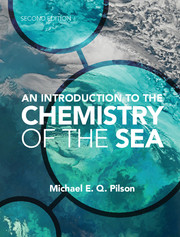Book contents
- Frontmatter
- Contents
- Preface
- Acknowledgments
- 1 Introduction
- 2 The water in seawater
- 3 Salinity, chlorinity, conductivity, and density
- 4 Major constituents of seawater
- 5 Simple gases
- 6 Salts in solution
- 7 Carbon dioxide
- 8 Nutrients
- 9 Trace metals and other minor elements
- 10 Radioactive clocks
- 11 Organic matter in the sea
- 12 Anoxic marine environments
- 13 Exchanges at the boundaries
- 14 Chemical extraction of useful substances from the sea
- 15 Geochemical history of the oceans
- Appendix A The chemical elements
- Appendix B Symbols, units, and nomenclature
- Appendix C Physical properties of seawater
- Appendix D Gases
- Appendix E Carbon dioxide
- Appendix F Dissociation constants and pH scales
- Appendix G Solubility of calcium carbonate
- Appendix H Effects of pressure
- Appendix I Radioactive decay
- Appendix J Geochemical reservoirs, and some rates
- Appendix K Sound absorption
- Epilogue
- Questions for chapters
- Glossary
- References
- Index
- Miscellaneous end matter
- References
8 - Nutrients
Published online by Cambridge University Press: 05 February 2013
- Frontmatter
- Contents
- Preface
- Acknowledgments
- 1 Introduction
- 2 The water in seawater
- 3 Salinity, chlorinity, conductivity, and density
- 4 Major constituents of seawater
- 5 Simple gases
- 6 Salts in solution
- 7 Carbon dioxide
- 8 Nutrients
- 9 Trace metals and other minor elements
- 10 Radioactive clocks
- 11 Organic matter in the sea
- 12 Anoxic marine environments
- 13 Exchanges at the boundaries
- 14 Chemical extraction of useful substances from the sea
- 15 Geochemical history of the oceans
- Appendix A The chemical elements
- Appendix B Symbols, units, and nomenclature
- Appendix C Physical properties of seawater
- Appendix D Gases
- Appendix E Carbon dioxide
- Appendix F Dissociation constants and pH scales
- Appendix G Solubility of calcium carbonate
- Appendix H Effects of pressure
- Appendix I Radioactive decay
- Appendix J Geochemical reservoirs, and some rates
- Appendix K Sound absorption
- Epilogue
- Questions for chapters
- Glossary
- References
- Index
- Miscellaneous end matter
- References
Summary
. . . the biochemistry of the ocean is curiously complex . . . and its processes are conducted upon an enormous scale.
Frank Wigglesworth Clark 1908As used in the marine-science literature, the word nutrient does not mean the food we eat; instead, it usually refers to the important and commonly measured elements needed for the growth of plants: phosphorus, nitrogen, and silicon. Of course, many other elements are necessary for life. Hydrogen, carbon, oxygen, and sulfur are essential, and such elements as iron, copper, cobalt, zinc, and boron are required in traces. In seawater, carbon dioxide, sulfate ions, and borate are abundant and never limiting, so, conventionally, they have not been included among the nutrients. The status of several other elements is uncertain; because of the very low concentrations in which they are needed it is only in recent decades that much experimental work could be accomplished. This chapter deals primarily with the so-called major nutrients: phosphorus, nitrogen, and silicon.
Phosphorus
Because of its crucial role in biological activity, phosphorus has been extensively studied. Phosphorus has certain unique properties that appear to qualify it for its role as both an essential constituent of the genetic material (RNA and DNA) of all organisms, and an essential participant in many energy-transforming mechanisms (via ATP, etc.) of all organisms (Westheimer 1987). Since all living things require phosphorus, and the element is present in seawater in very low concentrations, the amount present in a body of water must often set an upper limit to the biomass of living organisms that can grow there. (There are, however, many localized situations where one or another substance may take over the role of the limiting nutrient. There is further discussion of this in Sections 8.4 and 8.5.)
- Type
- Chapter
- Information
- An Introduction to the Chemistry of the Sea , pp. 176 - 227Publisher: Cambridge University PressPrint publication year: 2012



